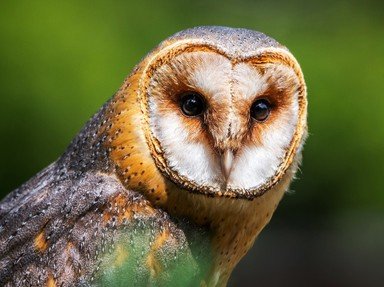Quiz Answer Key and Fun Facts
1. All owls belong to the order Strigiformes, which is comprised primarily of which of these kinds of birds?
2. Unlike many birds that hunt, owls have two forward-facing eyes as opposed to eyes located on opposite sides of their heads. What is this front-facing kind of vision known as?
3. Humans can generally rotate their necks (to one side) anywhere from 60 to 90 degrees. Owls can do it up to 270 degrees. What is one of the main reasons that owls are far superior in this regard?
4. In most owl species, the female is physically larger than the male.
5. Interestingly, in some species of owl such as the barn owl, a certain body part develops asymmetrically in size and location so as to aid it while hunting. Which body part is it?
6. Owl plumage often utilizes camouflage to both protect the owls from predators as well as hide from prey. What is the more general term in ecology for this kind of adaptation?
7. The vast majority of owls are active at night, but the burrowing owl is an exception. What is the term for animals that are active during the day?
8. Pictured are the talons of a barn owl. What adaptation do owls have that set them apart from other raptors and give them an advantage while hunting?
9. Owls have a tendency to swallow their prey whole, later regurgitating the indigestible parts of the animals. One can come across one of these masses, known as what in the ornithological word?
10. Like many animals, owls have a translucent third eyelid that helps protect their eyes and keep them moist. What is this third eyelid called?
Source: Author
trident
This quiz was reviewed by FunTrivia editor
rossian before going online.
Any errors found in FunTrivia content are routinely corrected through our feedback system.
